
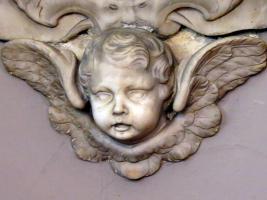
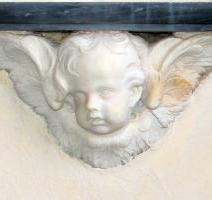
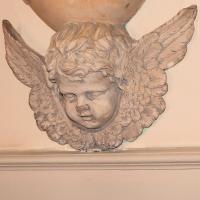
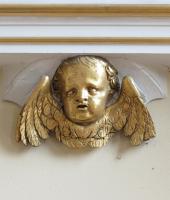
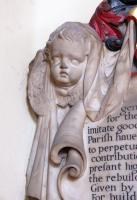
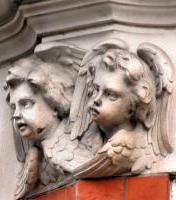
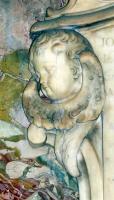
Winged cherub heads are a common feature in Victorian and Edwardian sculpture, and earlier too, and this page looks at some examples of the breed and their variety. We find carved cherub heads in two main settings outdoors as architectural sculpture, and on funereal monuments, mostly inside the churches, but also carved in relief on headstones. They are generally purely decorative rather than emblematic of anything in particular, and tend to the sentimental and the pretty all too easy to do with their baby faces, big, round eyes, plumpness of cheek, and pouting lips. At the top of this page are some winged cherub heads showing all of these features, exemplifying softness and sweetness. Click to enlarge to see properly.
Carved cherub heads with wings spread wide.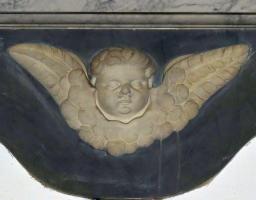
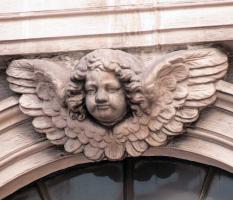
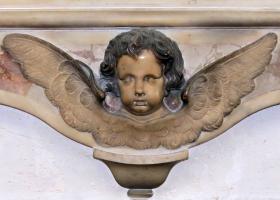
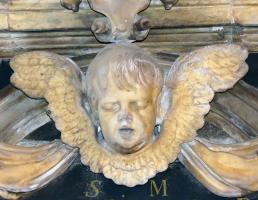
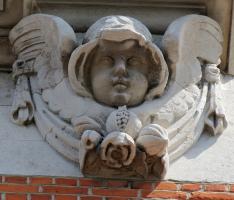
If we close our eyes and imagine a sculpture of a cherub head, then the chances are that we imagine the wings outstretched, and indeed this is the most typical pose. There are several variations on this, as shown here. Here above are some funereal and architectural with their wings spread in a smooth curve, as if one single double headed wing. The wings can be more stretched out, or tending more upwards, closer to the head. The wings can be full, or rather thin and meagre. Compared to a birds wings, although the proportions vary from cherub to cherub, they are really rather short, with the wing typically about double in length to the size of the head. Again letting our thoughts free, we could imagine with some modestly vigorous fluttering, that these cherub heads could plausibly fly well, perhaps not the skinny winged one in the centre but certainly gliding would be aerodynamically beyond them.
Next, the sculptor can make some variation of the stretched-wing pose: the first example above, with really very small wings, has them half closed forming a frame to the ugly face. By contrast, the next example has the wings outwards but more downwards, as if near the downbeat of a wingbeat. The third example, above right, has a heraldic winged cherub head, with the wings still together as one continuous feathered line, reduced to vestigial shortness, though outstretched. Rather appealing, in emphasising the chubbiness of the whole, and allowing the creatures hair to wispily drift outwards to either side of the little round head. And the example far right has our outstretched double wing, with drapery in front of the two halves. Quite unusual.
Wings carved as separate structures.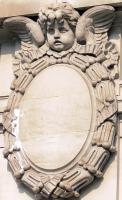
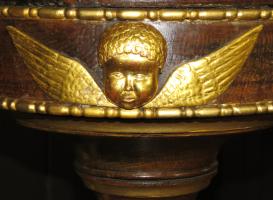
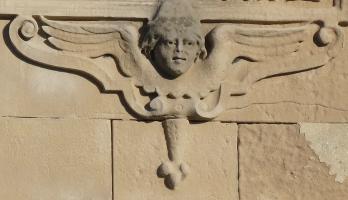
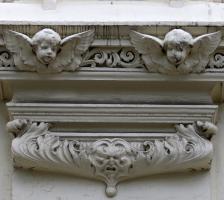
The alternative to one double wing is to have two completely separate wings. Far left above, a completely separated pair of short, fat wings to mirror the short, fat face of the cherub, positioned above an oval wreath. Next a relief example in gilt wood, a much older example not aiming at chubbiness or prettiness at all. Forward in time again to the 1900s we have to the right a cherub head with long, outstretched separate wings we can see some bony structure to them as well as the feathers. And far right, two carefully carved winged cherub heads with enough feathers to give a really believable flying creature it would cause no surprise if they were to take flight and climb rapidly into the sky.
Cherub heads carved with wings crossed.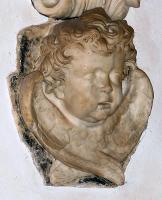
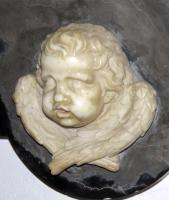
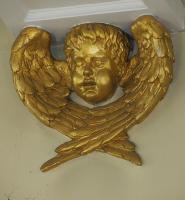
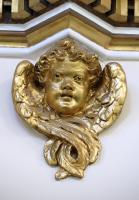
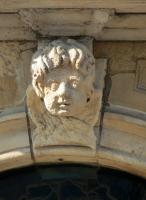
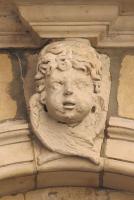
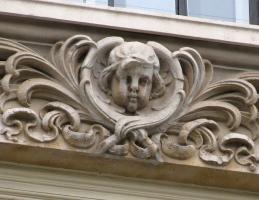
Sculptures of cherub heads with the wings crossed or folded across each other are particularly adapted to the bases of church monuments, and in churches more generally. The two above left are 17th Century, the first in All Saints Carshalton Parish Church in Essex, the second in St John the Baptist, Aldbury, Hertfordshire. The central two are typical of architectural winged cherub heads within the church, gilt and ornamental, and characteristic of many churches with 17th and 18th Century interiors. The curled round wing feathers of the second example is a nice compositional touch. The three on the right hand side above are architectural and outdoors: first a pair of very similar heads carved as keystones, a favourite theme of this website (see this page and this page and this page) they are early ones I think rather than Victorian (though in architecture, Victorian carved cherub heads are quite frequent), and the very right-most one above is an Edwardian, Art Nouveau cherub head. The wings frame the head like a cup, and merge indistinguishably at the base with the ends of the crossed branches which send ferny fronds to either side; a nice composition. The whole is a study in harmony, despite the lumpy little chin of the cherub, which is actually a device to show the plumpness of the cheeks.
Wings asymmetrically posed: one up, one down.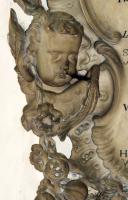
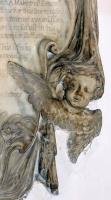
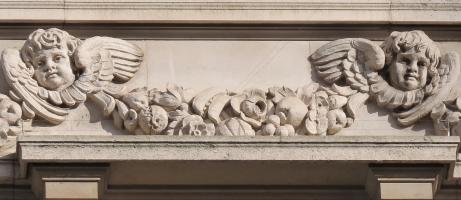
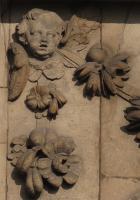
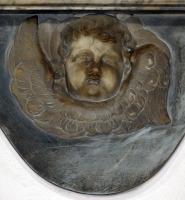
One wing up and one down is another pose for the carved cherub head. It is often found on 18th Century cartouche monuments with a winged cherub head on each side, giving balance, but can be used in the middle, as in the picture far right above. Architectural examples are above centre right you will need to click to enlarge the pair in the centre form an Edwardian example, most exuberant, with the wing position giving a sense of fast flight: if you ever actually see cherub heads flying at speed and are lucky enough to take a photo, I would think this is the pose you would capture.
Cherub heads with more than one pair of wings.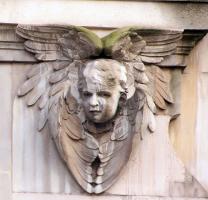
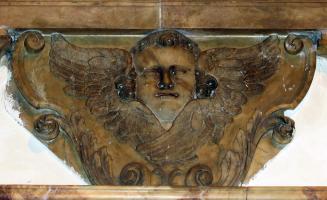
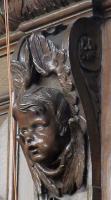
One more thing to say about wings which is to mention that from time to time we find many-winged cherub heads either four or six. At their best, they remind us more of butterflies, particularly the one above left. The one on the right is actually a carved wood example, from a bracket.
Cherub heads as part of the carved decoration of pillars.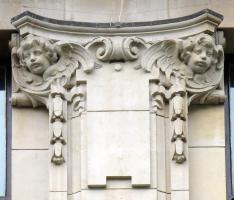
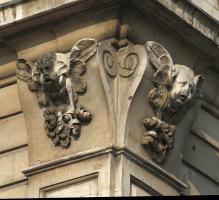
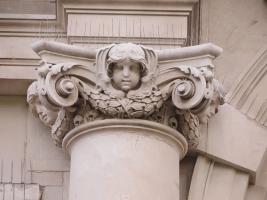
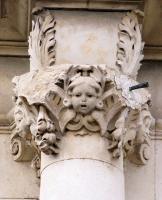
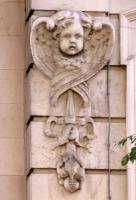
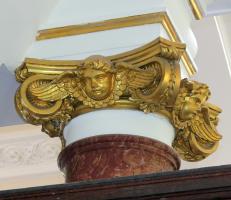
We have noted that winged cherub heads are often sculpted on cartouche monuments in churches. Out of doors, we sometimes find them on the capitals of pillars, or their flattened equivalents, pilasters, as shown above. To the left, a fine pair of early 20th Century winged cherub heads look outwards from a pilaster. Next, another pair on a corner pilaster, with scrolling as in the wooden example we saw above; these are of the multi-winged type, and are here combined effectively with carved flowers, cones and leaves to give more depth to the capital.
Next a Classical Edwardian Ionic pillar with three heads, the wings reduced greatly - hopeless indeed to find one of these ones in actual flight. Even more so in the next example, again tri-headed, with the wings as downward pointing appendages and leafy uppers. The open rounded mouth is effective as suggesting innocence. Then a cross-winged example, heavy jowled but quite sweet, running down the surface of a pilaster, with hanging pomegranate carvings for added depth. And far right, I wanted to include an internal example, and have chosen a gilt 18th Century pillar capital with carved cherub heads all the way round. The frontmost head seems to have a bald pate or be wearing a skullcap, giving a clerical look. There is a page about carved pillars on this site here.
More architectural carvings of cherub heads: corbels and brackets and a keystone.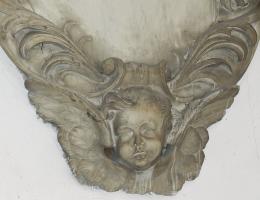
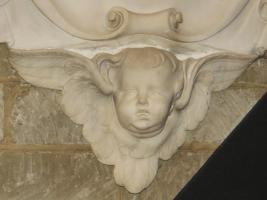
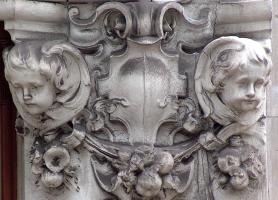
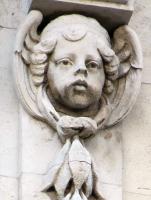
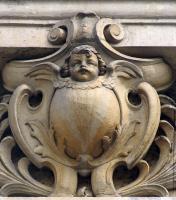
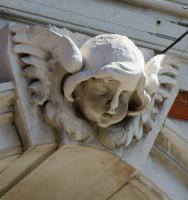
Winged cherub heads as part of the architecture are not confined to pillars: the other main usage is in brackets or corbels, the supporting element at the base of some projecting structure. The first two examples above on the left are both from cartouche monuments in the church: in both cases we can imagine the roughly upside-down pyramidal block of marble which was cut into to make the winged head. In the centre, a double example, two rather winsome carved heads supporting some shelf above, with flowers, scrolls, drapery and a small cartouche completing the design. Then another corbel with hanging flowers - the eyes, pouting lips and snub nose make this one perhaps too much on the sweet side. Next, one of a row of supporting corbels for the projecting shelf above, with tiny winged cherub heads as an accent to the main design, and really far too small to notice from ground level, in this case 4 storeys down. And far right, is an example of a keystone head carved as a winged cherub head; we have seen a couple of other examples like this further up the page.
We have seen pairs of cherub heads, and there is a special case where the heads come close to form a single composition. Above left, a sequence of three examples show the heads becoming closer, and then in the next two examples, they touch and kiss, the second of these being up there with the most sentimental Victoriana, though they in fact date from about 1700. And finally, far right, a gravestone with two pairs of winged cherub heads, wing behind wing, foreheads just not quite touching.
Cherub heads in compositions of three.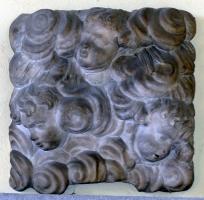
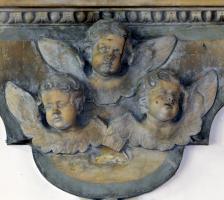
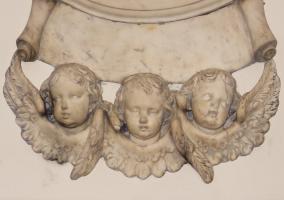
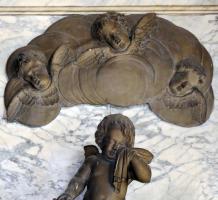
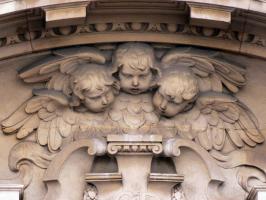
We need not stop at a pair: here are some trios. First three cherub heads among clouds the remnant of a bombed monument in St Nicholas Church, Deptford. Then another triangular composition on a monument. In the central picture above, we have three winged cherub heads in a line, the upturned outside wings giving a fine curve and harmonious and satisfying shape; the faces are of unusual purity. To the right, two cases of an upward curved group, the final one being an outdoor terra cotta example with the heads brought together in an overly sweet ensemble.
Most of the winged cherub heads we have seen have been expressionless, but I wanted to give a few cases where there is an undeniable expression. Above left, a sickly looking cherub with tongue almost protruding and half-shut eyes. Then one with its frown and downward turning mouth is a study in petulance. In the centre, what seems to be a singing one, between crossed trumpets and swords, really nicely carved. To the right, a Gargoyle expression on what I would think is an Edwardian sculpture. And then another one with open mouth and visible tongue, singing again: the careful modelling of the surfaces shows a most skilled sculptor at work.
Winged cherub head blowing a trumpet.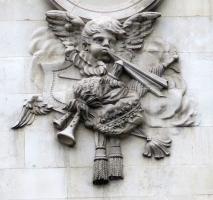
Winged cherub heads actually blowing vigorously may also be found, as in the example above, where I think what we are seeing is intended as a wind. The exotic accoutrements below suggest it may be emblematic of the East Wind. And below, finally, are a few other examples to illustrate the breadth of what the sculptor can accomplish with the winged cherub head, including one with two pairs of wings brought round to form a circle around the head, a bronze example, and one which looks more like an owl than just a head.
This page was originally part of a 'sculpture of the month' series, for December 2016. Although the older pages in that series have been absorbed within the site, if you would wish to follow the original monthly series, then jump to the next month (January 2017) or the previous month (November 2016). To continue, go to the bottom of each page where a paragraph like this one allows you to continue to follow the monthly links.
Cherub sculpture // Angel sculpture // Mermaid sculptures
Architecture pages // Sculpture pages
Allegorical sculpture // Introduction to church monuments // Obelisk monuments
Visits to this page from 4 Dec 2016: 11,807